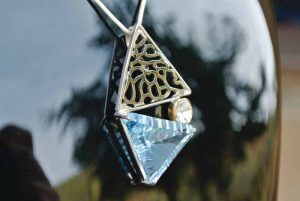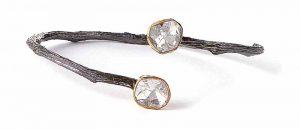Foundations for the future

Photos courtesy Neeta Gupta
A breakthrough came in the 16th century, when polishers were able to create a flat table facet by grinding away the upward-facing point. They called this a ‘table cut.’ The subsequent century saw advancement in the grinding process and the creation of rose-cut diamonds. This cut was essentially a flat bottom with facets at the top. The stone resembled the petal of a rose, imitating the narrowing spiral of the petals.
Perennially popular
In modern times, Tiffany & Co. gave a rebirth to rose-cut diamonds. Around 100 years ago, the company set the rose-cut diamond in an open mount so light could shine through the stone, giving it an enhanced dazzle effect. Years later, with more and more jewellery innovation, rose-cut diamond lovers have been able to add sparkle to the rose cut by baking thin layers of gold or silver at the bottom of the diamond. The precious metal helps reflect more light through the gem without having to alter the original cut.
Rose-cut diamonds have become very popular these days, with numerous jewellery designers using them. They were a dominant trend in 2017, whether used to encircle a main coloured gemstone or as a standalone in a bold design. These cuts can be found in some form at nearly every jeweller. Some use rose-cut diamonds to add a vintage edge to designs; others make the cut seem totally modern by setting the diamonds in white gold or platinum and centering them on symmetrical lines.
Slices of life
The trendsetter for 2018 seems to be sliced diamonds. These are very thin slices of diamonds, sometimes only about 4 mm (0.15 in.) in height, which have large, asymmetrical, and shallow facets. The best-quality pieces have very good polish on them. The advancement in polishing techniques makes these diamonds compete well with the other shapes of diamonds. When choosing sliced diamonds for my designs, I look for the lustre and quality of polish. Retailers should also look for thickness—it is difficult to handle sliced diamonds with lesser thicknesses, and you will end up with broken, unusable pieces.
Clear-cut confidence

The most popular and globally produced diamond has been the brilliant-cut diamond. The round-shaped brilliant cut, a symbol of unending love, was invented in the 1900s. With it came the terminology to precisely define the qualities of a diamond—the four Cs. Colour, clarity, carat weight, and cut have become the international language jewellery professionals use to describe and evaluate diamonds. The resultant increase in consumer awareness has empowered even the average purchaser to make an informed decision.
These new consumers are more confident in their purchases. They like to shop around to find the most reliable retailer with the best deal. Retailers today must keep in mind they should not try to outsmart these new consumers, but rather try to win their confidence by appreciating the awareness they have, marketing to them at a reasonable profit margin.





